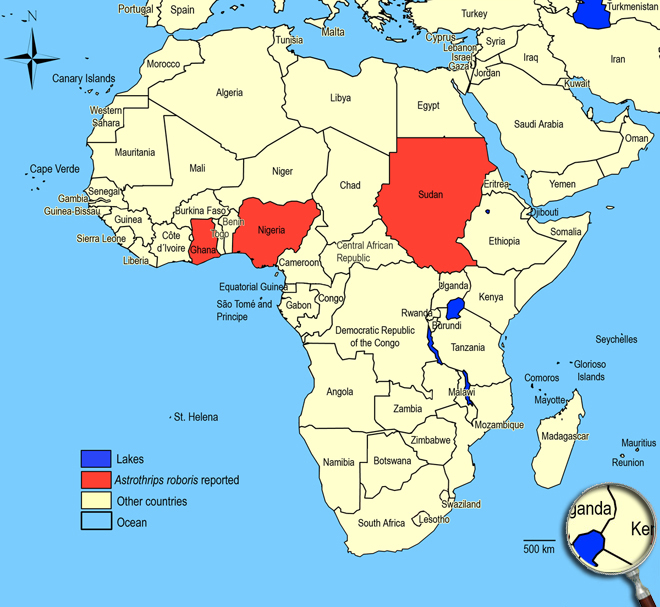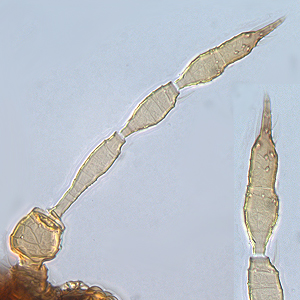Astrothrips roboris (Bagnall, 1919)
Panchaetothripinae, Thripidae, Terebrantia, Thysanoptera
Figures
Fig. 1: 8-segmented antenna, terminal segments V-VIII more or less fused
Fig. 2: Head dorsal with ocellar triangle
Fig. 3: Head ventral with mouth cone
Fig. 4: Pronotum
Fig. 5: Meso- and metanotum
Fig. 6: Fore wing, basal region of fore wing
Fig. 7:
Tergite II anterolaterally with numerous recurved claw-like microtrichia
Fig. 8: Tergites IV and V
Fig. 9: Sternites IV and V
Fig. 10: Tergites VIII-XI and ovipositor
Fig. 11: Tergites VIII-XI
Introduction and recognition
Astrothrips roboris is a polyphagous pest on various flowers and leaves. Female macropterous; body brown; abdominal segments 9 & 10 often paler, apex of 10 shaded; antennae, tarsi and apices of tibiae yellow; fore wings yellowish brown, two dark brown cross bands bearing dark veinal setae, wing apex pale (Fig. 6). Antennae apparently 5-segmented; segments V-VIII more or less fused into one long segment, III & IV with simple sensorium (Fig. 1). Head constricted to base; cheeks bearing reticulate sculpture with strongly raised walls (Fig. 2 and 3); ocellar area slightly elevated over antennal bases. Pronotum with anterolateral margins raised, posterior submargin with strong transverse ridge (Fig. 4). Mesonotum weakly cleft medially. Metanotum without heavily defined triangle medially; median setae arising near posterior (Fig. 5). Mesofurca without spinula; metafurca elongate and Y-shaped. Mid and hind tarsi 1-segmented.Fore wing first vein close or fused to costal vein (Fig. 6), first vein with irregular row of stout setae; second vein with about 9 setae; costal fringe cilia longer than setae. Tergite II anterior margin strongly constricted, anterolaterally with many claw-like microtrichia (Fig. 7); tergite VIII with marginal craspedum entire medially but toothed laterally; median split on X complete (Fig. 11).
Male similar to female; tergite IX without stout setae; sternites IV-VII with U-shaped glandular area.
Taxonomic identity
Species
Astrothrips roboris (Bagnall, 1919)
Taxonomic history
Astrothrips (Gamothrips) connaticornis Priesner, 1964
Astrothrips pentatoma Hood, 1925
Tryphactothrips roboris Bagnall, 1919
Common name
-
Present taxonomic position
Family: Thripidae Stephens, 1829
Subfamily: Panchaetothripinae Bagnall, 1912
Genus: Astrothrips Karny, 1921
Genus description
The genus Astrothrips Karny, 1921
The genus Astrothrips currently includes 12 species, of which 10 are recorded from countries between India and New Guinea, but with 2 species from Africa. All of them are small dark species with banded wings, seem to be polyphagous, and they can be recognised by the elaborate raised sculpture on the head and pronotum, and the area of specialised cuticular processes laterally on tergit II (Mound & Kibby 1998).
Species description
Typical key character states of Astrothrips roboris
Coloration and body sculpture
Surface of head, pronotum and fore legs: with heavy, elaborate raised and reticulate sculpture
Body color: mainly brown to dark brown
Sculptured reticles on head and pronotum: with no internal markings
Antennae
Number of antennal segments: 5 (V-VIII more or less fused)
Form of sense cones on antennal segments III and IV: emergent and simple on segments III and IV
Terminal antennal segments: V-VIII forming a single unit
Head
Cheeks shape: constricted to basal neck
Head - occipital ridge dorsally: absent
Head: distinctly prolonged in front of compound eyes
Ocelli: present
Prothorax
Pronotal blotch or internal apodeme: absent
Pronotum shape: broadly rectangular
Pronotum surface: with mainly equiangular reticulations
Mesothorax
Mesonotum: with an incomplete median division
Metathorax
Metanotum with dominant sculptured triangle medially: absent (or with weakly defined reticulate triangular area medially)
Shape of metathoracic furca: elongate and Y-shaped
Wings
Fore and hind wings: present, more than half as long as abdomen (macropterous)
Fore wing veins: present
Fore wing first vein: close to or fused to costal vein
Fore wing first vein setal row: incomplete, with setae not closely and uniformly spaced
Fringe cilia arising: from sockets
Fore- and hind wing surface: covered with microtrichia
Apex of fore wing: with prominent terminal setae
Fore wing anterior margin (costal vein): with setae and cilia but cilia longer than setae
Fore wing costal fringe cilia: arising at anterior margin of wing
Fore wing second vein setal row: complete, setae uniformly spaced
Fore wing shape: mainly parallel sided or margins run continuously towards each other
Fore wing surface: not reticulate
Fringe cilia on posterior margin near apex: distinctly wavy (undulated)
Length of fore wing costal setae at middle of wing: longer than half of median wing width
Shape of fore wing apex: with mainly posterior margin curved to join anterior margin
Fore wings: alternating bands of dark and light
Fore wing extreme apex color: pale
Legs
Mid and hind tarsi: with one segment
Color of fore tarsi: pale or yellow, sometimes apical shaded or brown
Abdomen
Tergites: without distinctive tergal sculpture forming a series of arches on the antecostal ridges
Tergite II: anterolaterally with numerous recurved claw-like microtrichia
Tergites III to VI sculpture on lateral thirds: comprising mainly oblique reticulations
Tergites IV and V median setal pair: shorter than distance between their bases
Tergite VIII to X: without unusually long and stout setae
Tergite X: not tubular, longitudinally incomplete
Setae on abdominal tergite X: all setae slender or one pair stout and thorn-like

Similar or related species
Compared to other Panchaetothripini like Heliothrips, Hercinothrips and Caliothrips, Astrothrips roboris has an elaborate raised and reticulate sculpture on the head and pronotum, tergite II with an area of specialised cuticular structures (anterolaterally many claw-like microtrichia), and antennal segments V-VIII are more or less fused and apparently 5- or 6-segmented. Whereas other species possess head and pronotum with mostly reticulate sculpture not raised, no claw-like microtrichia on tergite II, and antennae with 7 or 8 distinct segments.
Biology
Life history
As with other thrips species the life cycle from egg to adult is dependent on temperature. The full cycle can take about 15 days (Lewis 1973) to over a month and adults may live for more than one month producing several generations in one year depending on seasonal weather.
Host plants
Apparently polyphagous on various flowers and leaves.
Crops: banana, cabbage, capsicum, cucurbit, Lima bean, palm, taro (old cocoyam), tobacco.
Vector capacity
None identified, but possible mechanical distribution of phytopathogenic fungi and bacteria.
Damage and symptoms
-
Detection and control strategies
-
Additional notes
-
Biogeography
Africa, Ghana (Aburi),
Nigeria (Ibadan, Asaba, Mokwa),
Sudan (Blue Nile Province - Gezirat El Fil near Wad Madani, Wad Madani, Kadugli)
African countries where Astrothrips roboris has been reported

The species Astrothrips roboris was not observed in surveys undertaken in East Africa on vegetables and associated weeds and crops.
Please click here for survey sites of all observed thrips species of Kenya, Tanzania and Uganda.

Bibliography
Bagnall RS (1919). Brief descriptions of new Thysanoptera - X. Annals and Magazine of Natural History, Zoology, Botany and Geology. (Serie 9) 4: 253-277
Bhatti JS (1968). The Tryphactothrips-complex in India, with a key to the world genera (Thysanoptera: Thripidae). Oriental Insects. 1 (3-4): 139-191
Hood JD (1925). Four new Thysanoptera from Africa. Proceedings of the Entomological Society of Washington. 27: 8-12
Lewis T (1973). Thrips: their biology, ecology and economic importance. Academic Press Inc., London Ltd., 349 pp
Mound LA (1968). A review of R. S. Bagnalľs Thysanoptera collections. Bulletin of the British Museum (Natural History), Entomology. Supplement 11: 1-181
Mound LA (1970). Studies on heliothripine Thysanoptera. Proceedings of the Royal Entomological Society of London. 39 (3-4): 41-56
Mound LA & Kibby G (1998). Thysanoptera: An identification guide, (2nd edition). CAB International, Wallingford and New York, 70 pp
Palmer JM (1990). Identification of the common thrips of Tropical Africa (Thysanoptera, Insecta). Tropical Pest Management. 36 (1): 27-49
Palmer JM, Mound LA & Du Heaume GJ (1989). 2. Thysanoptera, 73 pp. In Betts CR [ed.], CIE Guides to insects of importance to man. CAB International, Wallingford, Oxon, UK
Pitkin BR & Mound LA (1973). A catalogue of West African Thysanoptera. Bulletin de l’Institut Fondamental d’Afrique Noire, Série A. 35 (2): 407-449
Priesner H (1964). A monograph of the Thysanoptera of the Egyptian deserts. Publications de l’Institut du Desert d’Egypte (1960). 13: 1-549
Wilson TH (1975). A monograph of the subfamily Panchaetothripinae (Thysanoptera: Thripidae). Memoirs of the American Entomological Institute. 23: 1-354
----
Web links
Mound´s Thysanoptera pages
Thysanoptera Checklist
ICIPE Thrips survey sites
UNI Halle & Thrips sites
Thrips of California














